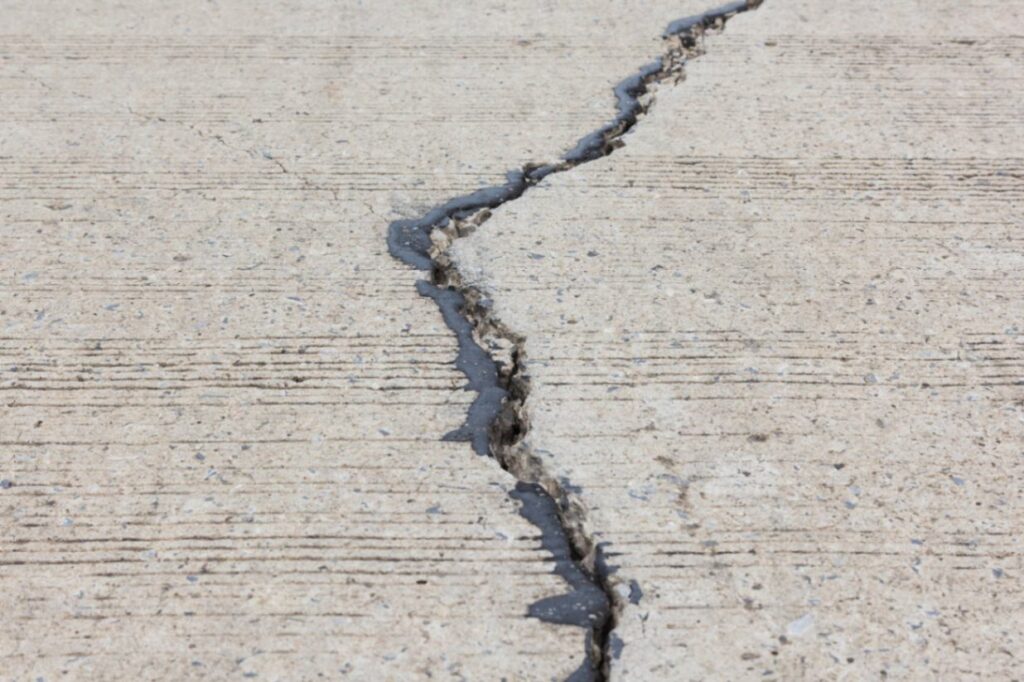Concrete cracking is a common issue that can stem from various factors, including temperature shifts and inadequate curing. Understanding these causes is crucial for effective prevention and repair. By identifying the specific reasons behind cracks, you can take proactive measures to protect your structures. However, addressing these issues isn’t always straightforward; the methods you choose can greatly impact the outcome. What steps will you take to guarantee your concrete remains durable?

Key Takeaways
- Concrete can crack due to temperature fluctuations, leading to thermal expansion and contraction without adequate control joints to manage stress.
- Excess moisture and poor drainage can cause water intrusion, resulting in cracking and structural damage over time.
- Improper curing techniques disrupt hydration, potentially leading to surface cracks; effective curing methods are essential for concrete integrity.
- Heavy loads and uneven weight distribution can create stress concentrations, resulting in cracks if the concrete is not designed for such loads.
- Repair methods like epoxy injection and surface sealing can restore structural integrity and prevent further moisture infiltration in cracked concrete.
Understanding Concrete Composition
Concrete, a composite material, is primarily made up of cement, water, aggregates, and additives. Understanding concrete composition is vital for achieving durable structures.
When you create concrete mixtures, the choice of aggregate types greatly impacts strength and workability. Coarse aggregates, like gravel and crushed stone, provide structural integrity, while fine aggregates, such as sand, fill voids and improve cohesiveness.
The water-cement ratio is critical; too much water weakens the mix, leading to cracking. Additives may enhance specific properties, like setting time or resistance to environmental factors.
Temperature Fluctuations and Thermal Expansion
Temperature fluctuations can considerably affect concrete, leading to expansion and contraction that may result in cracking.
Understanding the dynamics of thermal expansion is vital for effective concrete management, as it helps you anticipate potential issues.
Implementing proper insulation and protection techniques can mitigate these risks and improve the durability of your concrete structures.
Impact of Temperature Changes
As temperatures fluctuate, the materials in concrete expand and contract, leading to significant stress within the structure. This phenomenon is particularly pronounced during temperature extremes, where rapid changes can cause the concrete to crack if proper precautions aren’t taken.
Seasonal variations also play a critical role; for instance, winter’s cold can cause contraction, while summer’s heat can lead to expansion. If your concrete lacks adequate control joints, these stresses can accumulate over time, resulting in visible cracking.
It’s crucial to take into account these temperature impacts during the design phase, ensuring you use appropriate materials and techniques to mitigate the risks associated with thermal changes. By understanding these dynamics, you can better protect your concrete from the damaging effects of temperature fluctuations.
Thermal Expansion Dynamics
When subjected to varying temperatures, the materials within concrete undergo thermal expansion and contraction, which can greatly influence the integrity of the structure.
As temperatures rise, the concrete expands, creating internal thermal stresses. Conversely, when temperatures drop, it contracts. If these stresses exceed the material’s tensile strength, cracks may develop.
To mitigate this, incorporating expansion joints is vital. These joints allow for movement, accommodating the natural expansion and contraction of the concrete without compromising structural integrity.
Insulation and Protection Techniques
The impact of temperature fluctuations on concrete structures underscores the importance of insulation and protective measures. To minimize thermal expansion effects, you should consider using high-quality insulation materials such as rigid foam or mineral wool. These materials provide a thermal barrier, reducing heat transfer and helping regulate temperature extremes within the concrete.
Additionally, applying protective coatings can greatly improve the durability of your concrete. These coatings, which can include epoxy or polyurethane, shield the surface from moisture infiltration and chemical exposure, further mitigating cracking risks.
Regular inspections and maintenance of both insulation and coatings guarantee they remain effective, allowing you to proactively address potential issues before they escalate into costly repairs. Prioritizing these techniques can extend the lifespan of your concrete structures.
Moisture and Water Intrusion
Moisture and water intrusion greatly contribute to concrete cracking, often leading to structural damage if left unaddressed. To prevent this, effective moisture control and water management strategies are crucial.
Guarantee proper drainage around your concrete surfaces to divert water away, minimizing saturation risks. Utilize sealants designed for concrete to create a barrier against moisture penetration.
Additionally, monitor humidity levels in enclosed spaces, as excessive moisture can weaken concrete integrity over time. Implementing proper waterproofing membranes during construction can also mitigate future water intrusion issues.
Regular inspections can help identify potential problems early, allowing you to take proactive measures. By focusing on these strategies, you can greatly reduce the risk of cracking associated with moisture and water intrusion.
Improper Curing Techniques
Improper curing techniques can greatly worsen the problems caused by moisture and water intrusion, leading to premature cracking in concrete structures.
When you neglect appropriate curing methods, you disrupt the essential hydration processes required for concrete to achieve its ideal strength. Insufficient moisture retention during the curing period can result in rapid evaporation, causing surface cracks and compromised integrity.
You should always implement effective curing practices, such as using wet coverings or curing compounds, to maintain moisture levels. Additionally, curing should continue for at least seven days to guarantee proper hydration.
Heavy Loads and Structural Stress
When concrete is subjected to heavy loads and structural stress, it can lead to considerable cracking if not properly accounted for in the design phase. To guarantee structural integrity, engineers must evaluate load distribution throughout the concrete structure.
Uneven load distribution can create stress concentrations, overwhelming specific areas and causing cracks. It’s vital to contemplate factors such as the weight of vehicles, equipment, and any additional loads that may be applied.
Reinforcement methods, like steel rebar or fiber additives, can improve the concrete’s ability to withstand these stresses. Additionally, regular inspections can help identify potential issues before they escalate into severe damage.
Ground Movement and Soil Settlement
Although ground movement and soil settlement often occur gradually, their effects on concrete structures can be significant and sometimes catastrophic.
Soil erosion, whether from water or wind, can undermine foundation stability, leading to uneven settling. As the soil beneath your concrete shifts, it creates voids that compromise the integrity of the structure. You might notice cracks forming as the concrete adjusts to these changes, leading to further damage over time.
To prevent these issues, guarantee proper drainage around your property and consider soil stabilization techniques if you’re in an erosion-prone area. Regular inspections can help you identify early signs of soil movement, allowing you to take proactive measures to maintain foundation stability and avoid costly repairs.
Chemical Reactions and Deterioration
Chemical reactions can greatly impact the longevity and strength of concrete structures, often leading to deterioration over time.
One significant factor is the alkali-silica reaction (ASR), where reactive silica in aggregates interacts with alkalis in cement, generating expansive gels. This can cause internal pressure, resulting in cracking.
Additionally, sulfate attack occurs when sulfates in groundwater react with hydration products, leading to volume expansion and cracking.
Carbonation, the process where carbon dioxide penetrates concrete and reacts with calcium hydroxide, can also weaken structural integrity.
To mitigate these chemical reactions, you should consider using low-alkali cement, selecting non-reactive aggregates, and maintaining ideal moisture levels.
Understanding these chemical reactions is essential for preventing concrete deterioration and ensuring structural resilience.
Repair Methods for Cracked Concrete
When it comes to repairing cracked concrete, two effective methods stand out: epoxy injection and surface sealing techniques.
You’ll find that epoxy injection fills cracks and restores structural integrity, while surface sealing creates a protective barrier against moisture and further damage.
Understanding these methods will help you choose the right approach for your specific repair needs.
Epoxy Injection Method
The epoxy injection method is a popular and effective technique for repairing cracked concrete, especially in structural applications. This method involves injecting a low-viscosity epoxy resin into the crack, allowing it to penetrate deeply and bond with the surrounding concrete.
For best results, verify the crack is clean and free of debris before beginning the epoxy applications. You’ll typically use a specialized injector that creates a pressure seal, promoting thorough crack sealing and strengthening the overall structure.
Once the resin cures, it restores the integrity of the concrete and prevents further water infiltration. This method is particularly suited for horizontal and vertical surfaces, offering a durable solution to cracked concrete issues in various environments.
Surface Sealing Techniques
Surface sealing techniques provide a vital approach to addressing cracked concrete by creating a protective barrier that prevents moisture infiltration and further damage.
You’ll find that the surface sealing benefits include improved durability, reduced maintenance costs, and enhanced aesthetics.
Several sealing material types are available, such as acrylics, polyurethanes, and epoxies, each offering unique properties for specific applications.
Acrylic sealers are great for surface protection and UV resistance, while polyurethanes provide superior flexibility and chemical resistance.
Epoxy sealers, on the other hand, bond well with concrete and offer robust protection against heavy wear.
Selecting the appropriate sealing material type based on your concrete’s condition and intended use guarantees long-lasting results and mitigates future cracking risks.
Frequently Asked Questions
How Long Does Concrete Typically Last Before Cracking Occurs?
Concrete typically lasts 30 to 40 years before showing signs of cracking. This concrete lifespan can vary based on environmental factors and quality of installation, influencing the cracking timeline you might experience in your projects.
Can I Prevent Cracks by Choosing Specific Concrete Mixes?
Yes, you can prevent cracks by choosing specific concrete mixes. Adjusting mix composition for strength and utilizing proper curing techniques improves durability, minimizing the likelihood of cracking over time. Prioritize these factors for ideal results.
What Are the Signs of Underlying Soil Issues?
You’ll notice signs of underlying soil issues through uneven floors, cracks in walls, and fluctuating moisture levels. Soil settlement often accompanies these symptoms, indicating potential instability that requires prompt assessment and remediation to prevent further damage.
How Often Should I Inspect My Concrete Surfaces?
You should inspect your concrete surfaces at least twice a year. Regular assessments help you identify surface conditions early, allowing for timely maintenance and preventing potential issues, ensuring the longevity and durability of your concrete installations.
Are There Specific Seasons When Concrete Is More Likely to Crack?
Concrete’s more likely to crack during winter weather due to freezing and thawing cycles, and summer heat can exacerbate drying, leading to shrinkage. Monitoring these conditions helps you anticipate and mitigate potential damage effectively.
Conclusion
To summarize, understanding the causes of concrete cracking is crucial for effective prevention and repair. By addressing factors like temperature fluctuations, moisture intrusion, and improper curing, you can greatly improve the durability of your concrete structures. Implementing regular inspections and utilizing appropriate repair methods, such as epoxy injection and surface sealing, will help maintain structural integrity. Taking proactive measures guarantees your concrete remains strong and resilient over time, ultimately prolonging its lifespan and reducing future repair costs.
